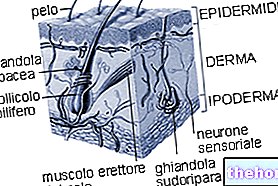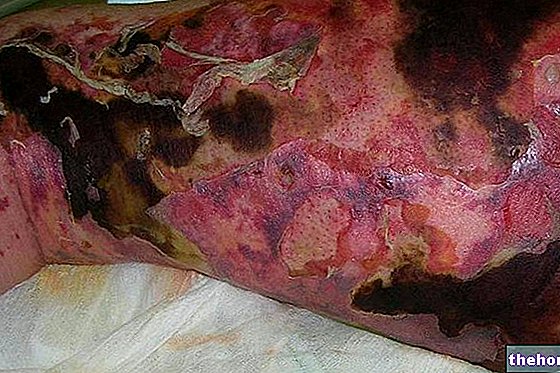Definition
Lipomatosis is a disorder that presents abnormal and circumscribed expansions of lipid tissue: it is in fact characterized by the formation of single or multiple lipomas, which can spread to all adipose areas of the body.

Lipomatosis is a very widespread condition and the resulting problem is mainly of an aesthetic nature. However, this strongly depends on the personal interpretation of the disorder, as well as on the type of lipomatosis that afflicts the patient. As will be seen in the course of the article, in fact, some forms of lipomatosis can cause even very serious complications.
Features
As mentioned, lipomatosis is characterized by the formation of a large number of lipomas that have a tendency to spread to different areas of the body.
Lipomas are mainly made up of adipose tissue (but in some cases they can also involve other tissues), have a soft consistency, are mobile to the touch and generally asymptomatic. These accumulations of fat that manifest themselves in the form of subcutaneous reliefs are considered, in most cases, as benign tumors.
Despite this, the clinical picture that derives from lipomatosis could generate interpretative problems regarding the differential diagnosis. Lipomas, in fact, tend to infiltrate the various tissues and are not prone to delimit themselves in specific areas: these factors contribute to the peculiarity of lipomatosis.
Classification
Classification and types of lipomatosis
Due to the fact that lipodystrophy is a phenomenon that affects every area of the body, some clear and defined clinical pictures can be distinguished, based on the affected area.
The main forms of lipomatosis and their related characteristics will be briefly described below.
Multiple symmetrical lipomatosis
It represents the most widespread form of lipomatosis, in which the lipomas are extensive and evolved, in particular in the region involving the neck, nape, groin, thighs, deltoid and shoulder blades. Lipomatosis is called "symmetrical" to emphasize the symmetry with which lipomas develop. It is a lipomatosis that mainly affects man, whose genetic transmission is of an autosomal dominant character, but other characteristics could also favor the development of the disease (chronic alcoholism).
In this pathology, two other sub-categories are distinguished:
- Multiple symmetrical type I lipomatosis, which mainly affects the neck and shoulder blades, the hollow veins and the trachea are the areas most affected and the lipomas present could be displaced in such a way as to attribute a bull-like appearance to the affected subject.
- On the other hand, type II symmetrical multiple lipomatosis is characterized by very expanded and excessively evolved lipomas, such as to reproduce an obesity-like situation. Multiple symmetric lipomatosis is often associated with ulcerations (caused by the decrease in peripheral sensitivity) and neuropathy. Surgical removal of lipomas is the only possible remedy.
Pelvic lipomatosis
In this form of lipomatosis, lipomas proliferate in the retroperitoneal area of the pelvis. The disease has a higher incidence rate among adult males who have passed the third decade of age. The causes that trigger pelvic lipomatosis are uncertain; however, some hypotheses have been formulated according to which the disease is related to localized obesity, but there is no certain evidence to prove this relationship. It does not seem a coincidence, in fact, that pelvic lipomatosis occurs mainly among obese subjects; it involves secondary symptoms such as constipation, fever, pelvic pain, hydronephrosis (swelling of a kidney) and frequent urge to urinate.
Epidural lipomatosis
In this condition, the lipomas are localized in the epidural adipose tissue. It occurs in obese people who have endogenous or iatrogenic (drug-induced) hypercortisonemia. Epidural lipomatosis can be asymptomatic or, in some cases, cause back pain and decreased muscle strength in the legs. Furthermore, epidural lipomatosis has been recorded in some subjects with Cushing's syndrome.
Painful lipomatosis
Painful lipomatosis (or Dercum syndrome) mainly affects women in senescence. The pathology is manifested by multiple and painful lipomas.
Abdominal, mediastinal and abdominal lipomatos
This type of lipomatosis is often associated with diseases such as diabetes mellitus and disorders such as fluid spillage into the peritoneum and dyspnoea (difficulty in breathing).
Krabbe's lipomatosis
Krabbe's lipomatosis is a hereditary syndrome characterized by the development of subcutaneous fat nodules (lipomas) that are not very large but relatively annoying and painful. They are preferentially located in the arms, thighs and trunk, areas in which there is an "alteration of sensitivity.
Krabbe's lipomatosis is a genetic condition transmitted as an autosomal dominant trait.
Roch-Leri mesosomatic lipomatosis
Roch-Leri mesosomatic lipomatosis belongs to the class of rare lipomatosis. Also in this case, it is an "autosomal dominant disease, whose lipomas spread over the forearms, thighs and trunk. Subjects affected by Roch-Leri mesosomatic lipomatosis manifest pain only if the lipomas are pressed against a hard surface and are related to vascular or muscular appendages, generally they do not evolve into malignant tumors.
Other forms of lipomatosis can be classified into:
- Asymmetric lipomatosis.
- Lipomatosis of the anal and perianal hilum.
- Lipomatosis of the pancreas.
- Lipomatosis of the shoulder girdle humeral.
Causes
In general, the causes that favor lipomatosis are still being studied. However, in addition to the more accredited genetic predisposition, it seems that lipomatosis is related to neurological and hormonal alterations, which could contribute to the formation and subsequent growth of the lipoma.
Furthermore, there is a theory according to which lipomatosis - hence the formation of lipomas - is connected to causes of traumatic origin.
Finally - for some types of lipomatosis - there are conditions that can represent risk factors (or, in some cases, the triggering cause) for the formation of the disorder, such as alcohol abuse (alcoholism), the use of some types of drugs or obesity.
Symptoms and Complications
The symptoms of lipomatosis can be different depending on the area in which it occurs and depending on its extent. Therefore, the symptoms of this disorder depend on the form of lipomatosis that affects the patient.
Generally speaking, the lipomas that give rise to lipomatosis are usually asymptomatic and represent more than anything else an aesthetic damage.
However, in some cases, they could cause pain and lead to unwanted consequences. This occurs, for example, if lipomas exert pressure on nerve endings, organs, tissues or blood vessels with their mass or with the eventual increase in volume.
Precisely because of the possible compression exerted on organs and tissues, the liposome can give rise - depending on the affected area - to a series of serious complications that require prompt medical intervention. Among these we remember:
- Difficulty swallowing
- Breathing problems
- Heart ailments;
- Gastrointestinal disorders;
- Paralysis;
- Strong pain.
Finally, it should not be forgotten that - even if rare - there is the possibility that lipomatosis can become complicated and evolve into possible malignant forms of cancer.
Treatment
As mentioned, one of the possible causes of lipomatosis is to be found in hormonal and neurological imbalances. Consequently, if it was demonstrated that neuronal disorders and hormonal modulations were the real predisposing factors for lipomatosis, it is possible to proceed with the pharmacological treatment of the disorder.
If the lipomatosis cannot be resolved with drug therapy, then the surgical removal of the accumulation of fat and lipomas remains the only way forward.
To do this, it is possible to resort to cosmetic surgery techniques such as liposuction or liposculpture.
Naturally, in the event that the lipomatosis evolves into a malignant tumor form, the patient must be subjected to adequate anticancer therapies (pharmacological and not, according to the doctor's opinion).









.jpg)


















